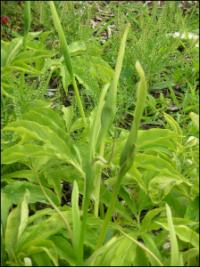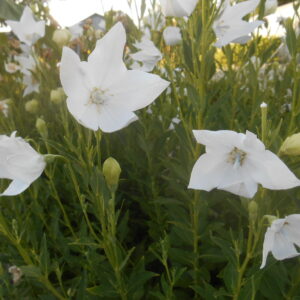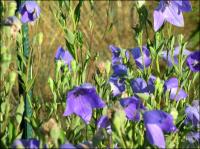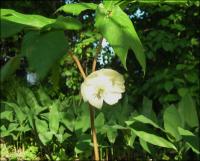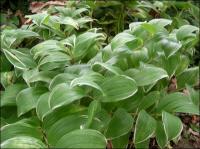Perennials & Biennials
Showing 361–368 of 511 results
-
Pinellia pedatisecta Green dragon Z 5-8
Green modified leaf (spath) curls around very thin, tall, graceful inflorescence (spadix) much like a primitive jack-in-the-pulpit. Grow this & hear your friends ask "what is that?"
Green modified leaf (spath) curls around very thin, tall, graceful inflorescence (spadix) much like a primitive jack-in-the-pulpit. Grow this & hear your friends ask “what is that?”
Size: 18" x 8"
Care: easy to grow in sun to part shade in moist to moist well-drained soil
Native: N & W ChinaIn Chinese called “Hu Zhang.” In Chinese medicine used to remedy ailments of the spleen, gallstones & coughs. Raw plant is toxic but neutralized by drying. Collected for western gardens by 1858.
-
Platycodon grandiflorus albus Balloon flower Z 3-9
Balloon shaped buds opening to white bells, blooming mid-summer to early fall.
Balloon shaped buds opening to white bells in mid-summer to early fall.
Size: 24" x 12"
Care: Full sun to part shade in moist well-drained soil. Heat and drought tolerant. Deadhead for rebloom.
Native: Eastern Asia
Wildlife Value: attracts hummingbirds, bees & butterflies
Awards: England's Royal Horticultural Society Award of Garden Merit.
Platycodon is Greek from platys meaning “broad” and kodon meaning “bell”, referring to the shape of the flower. Cultivated in China for hundreds of years where it is called Jie-geng. Chinese used the root boiled to cure a chill in the stomach. Mentioned in Man’yoshu, a Japanese anthology of poems written in the 8th century. German botanist Johann Gmelin (1709-1755) collected P. grandiflorus in Siberia in 1754. Gmelin’s Siberian mission, sponsored by Catherine the Great, took 10 years and nearly killed him. Gmelin introduced it to European garden cultivation by 1782. Robert Fortune found the white form in a nursery near Shanghai and sent it to England in 1845.
-
Platycodon grandiflorus Balloon flower Z 3-9
Balloon shaped buds opening to blue bells from mid-summer to early fall.
Balloon shaped buds opening to blue bells from mid-summer to early fall.
Size: 24" x 12"
Care: Full sun to part shade in moist well-drained soil. Heat and drought tolerant. Deadhead for rebloom.
Native: Eastern Asia
Wildlife Value: attracts butterflies, bees & hummingbirds
Awards: Received England’s Royal Horticultural Society Award of Merit.Platycodon is Greek from platys meaning “broad” and kodon meaning “bell”, referring to the shape of the flower. Cultivated in China for hundreds of years where it is called Jie-geng. The Chinese used the root boiled to cure a chill in the stomach. Mentioned in Man’yoshu, a Japanese anthology of poems written in the 8th century. German botanist Johann Gmelin first discovered P. grandiflorus in Siberia in 1754. Gmelin’s Siberian mission, sponsored by Catherine the Great, took 10 years and nearly killed him. Gmelin introduced it to European garden cultivation by 1782. Cultivated in the U.S. since the 1800’s. Received England’s Royal Horticultural Society Award of Merit.
-
Podophyllum peltatum Mayapple, Hog apple, Mandrake Z 4-9
White waxy cups in spring. Ephemeral, dies back in summer.
White waxy cups in spring. Ephemeral, dies back in summer.
Size: 18" x 4' spreading by rhizomes
Care: moist well-drained soil in full to part shade.
Native: Quebec to Minnesota, south to Florida & Texas, Wisconsin nativeNamed for its supposed resemblance to a duck’s foot (Anapodophyllum.) Mayapple root used medicinally by Native Americans – for the Iroquois & Delaware as a laxative and purgative, to purify the body and expel worms. Cherokee and Menomonee made the root’s juice to protect corn and potatoes from insects. Oneidas made a poltice for sores – cut every joint of root & bake half a day until brown then add water. Roots also used by Native Americans and early settlers as a purgative, emetic, “liver cleanser,” worm expellant, and to remedy jaundice, constipation, hepatitis, fevers and syphilis. Introduced 1664. You can hunt Morel mushrooms when Mayapples bloom.
-
Polemonium brandegeei Brandegee’ Jacobs-ladder, Yellow sky pilot Z 4-8
Hanging, tubular yellow, sometimes white blooms over frilly foliage, May-July
OUT OF STOCK
Hanging, tubular yellow, sometimes white blooms over frilly foliage, May-July
Size: 8” x 10”
Care: sun to part shade in very well-drained soil
Native: CO, NM, SD, UT, WY
Wildlife Value: attracts bees, butterflies & mothsCollected by Townshend Stith Brandegee in the ‘Valley of the Rio Grande, on the Los Pinos Trail’ c. 1870. Brandegee then sent it to Harvard botanist Asa Gray who identified and named it to honor its collector.
-
Polemonium reptans Greek valerian, Jacobs ladder Z 4-8
Cluster of light blue bell shaped blooms in May and June
Clusters of light blue bell shaped blooms in May and June
Size: 8-12” x 10”
Care: part shade in moist to moist well-drained soil, immune to Walnut toxins
Native: Ontario & Quebec to Alabama, west to MN & KS, Wisconsin nativeCollected for gardens before 1750. Meskwaki made a compound of roots as a physic and for urinary ailments.
-
Polygonatum falcatum var. variegatum Variegated Solomon seal Z 3-9
Solomon seal with white margined leaves, white dangling bells
Gracefully arching stems without branches but with white margined leaflets on both sides of the stem, nearly parallel and dangling ivory bells. Flowering in spring, each flower turns into a glaucous blue berry.
Size: 20" x 4' slow spreader
Care: moist to moist well-drained soil in shade.
Native: Japan
Wildlife Value: Birds eat the fruit. Pollen and nectar feed a number of bee species.
Awards: Great Plant Pick Award; Perennial Plant Assn’s 2013 Plant of the Year; Missouri Botanic Garden Plant of Merit, Great Plants for Great Plains, Pennsylvania Horticultural Society Gold MedalCommon name Solomon seal due to Medieval herbalists who opined that Biblical figure Solomon put scars on the rhizome of a European Solomon seal to demonstrate the plant’s curative powers. This variety 1st identified by Japanese botanist Takenoshin Nakai (1882-1952) in Botany Magazine of Tokyo 1924.
-
Polygonatum multiflorum Solomon’s seal Z 4-10
Dainty white flowers dangle from arching stems
Gracefully arching stems without branches with leaflets on both sides of the stem, nearly parallel and dangling ivory bells. Flowering in spring, each flower turns into a glaucous blue berry. The leaves “make a fine mass of elegant foliage,” Sanders, 1913.
Size: 5' x 10"
Care: shade in fertile, humusy, well-drained soil. Good dry shade plant, drought tolerant.
Native: Europe and Asia
Wildlife Value: Birds eat the fruit. Pollen and nectar feed a number of bee species.Greek physician Dioscorides named Polygonatum in the 1st century, which means “many jointed” referring to scars on the rhizome. Medieval herbalists opined that Biblical figure Solomon put scars on the rhizome to demonstrate the plant’s curative powers. P. multiflorum cultivated in English gardens by 1450. In 1596 English herbalist Gerard (1545-1612) endorsed its use to repair broken bones – mix the pulverized root and drink it with ale to “gleweth together the bones in very short space.” He also claimed fresh stamped root would cure cuts and bruises for “women’s willfulness in stumbling on their hasty husband’s fists.” According to Culpepper, Italian wives “much used” this remedy.

